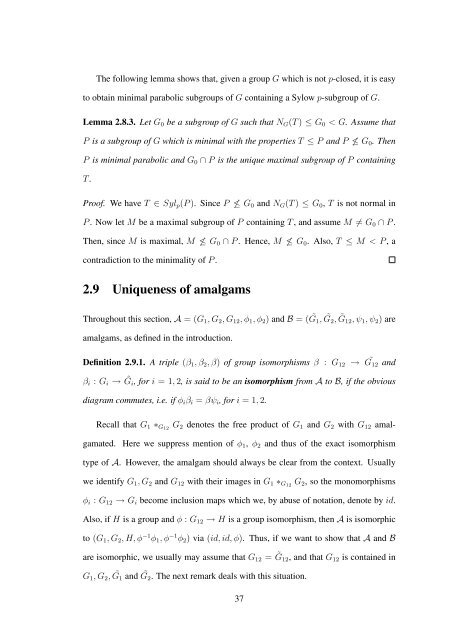SATURATED FUSION SYSTEMS OF ESSENTIAL RANK 1
SATURATED FUSION SYSTEMS OF ESSENTIAL RANK 1
SATURATED FUSION SYSTEMS OF ESSENTIAL RANK 1
Create successful ePaper yourself
Turn your PDF publications into a flip-book with our unique Google optimized e-Paper software.
The following lemma shows that, given a group G which is not p-closed, it is easy<br />
to obtain minimal parabolic subgroups of G containing a Sylow p-subgroup of G.<br />
Lemma 2.8.3. Let G0 be a subgroup of G such that NG(T ) ≤ G0 < G. Assume that<br />
P is a subgroup of G which is minimal with the properties T ≤ P and P �≤ G0. Then<br />
P is minimal parabolic and G0 ∩ P is the unique maximal subgroup of P containing<br />
T .<br />
Proof. We have T ∈ Sylp(P ). Since P �≤ G0 and NG(T ) ≤ G0, T is not normal in<br />
P . Now let M be a maximal subgroup of P containing T , and assume M �= G0 ∩ P .<br />
Then, since M is maximal, M �≤ G0 ∩ P . Hence, M �≤ G0. Also, T ≤ M < P , a<br />
contradiction to the minimality of P .<br />
2.9 Uniqueness of amalgams<br />
Throughout this section, A = (G1, G2, G12, φ1, φ2) and B = ( ˜ G1, ˜ G2, ˜ G12, ψ1, ψ2) are<br />
amalgams, as defined in the introduction.<br />
Definition 2.9.1. A triple (β1, β2, β) of group isomorphisms β : G12 → ˜<br />
G12 and<br />
βi : Gi → ˜ Gi, for i = 1, 2, is said to be an isomorphism from A to B, if the obvious<br />
diagram commutes, i.e. if φiβi = βψi, for i = 1, 2.<br />
Recall that G1 ∗G12 G2 denotes the free product of G1 and G2 with G12 amal-<br />
gamated. Here we suppress mention of φ1, φ2 and thus of the exact isomorphism<br />
type of A. However, the amalgam should always be clear from the context. Usually<br />
we identify G1, G2 and G12 with their images in G1 ∗G12 G2, so the monomorphisms<br />
φi : G12 → Gi become inclusion maps which we, by abuse of notation, denote by id.<br />
Also, if H is a group and φ : G12 → H is a group isomorphism, then A is isomorphic<br />
to (G1, G2, H, φ −1 φ1, φ −1 φ2) via (id, id, φ). Thus, if we want to show that A and B<br />
are isomorphic, we usually may assume that G12 = ˜ G12, and that G12 is contained in<br />
G1, G2, ˜ G1 and ˜ G2. The next remark deals with this situation.<br />
37

















